How to Propagate Schefflera (Umbrella Plant) at Home
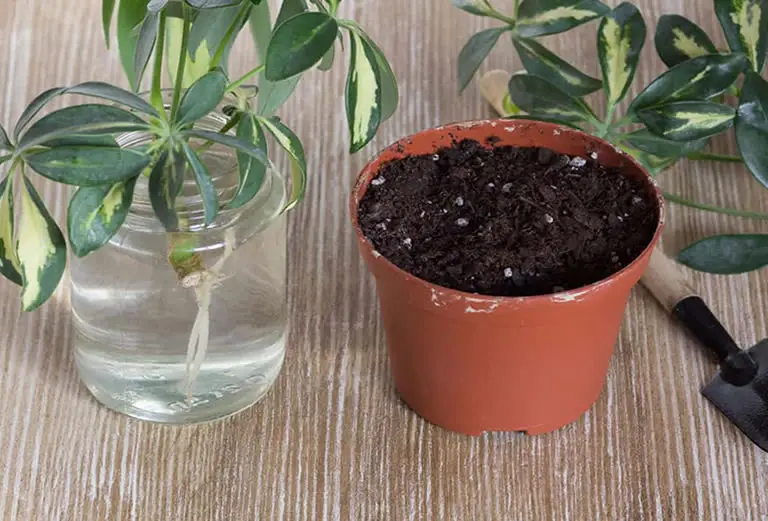
If you’ve got a lush Umbrella Plant (Schefflera arboricola or Schefflera actinophylla) and want more of it, propagation is an easy and rewarding way to expand your collection. Whether you’re trimming it back or rescuing a leggy stem, the methods below will show you how to root new plants and keep that iconic umbrella shape going.
Table of Contents
- Schefflera Basics
- Best Time to Propagate: When Growth Is Active
- Stem Cuttings in Water: The Most Popular Method
- Propagation in Pots: A Soil-First Option That Skips the Jar
- Air Layering: Great for Larger Plants
- Propagation by Division: Rare but Possible
- Outdoor Propagation: Warm Climates Only
- Caring for New Plants: Keep It Gentle
- Final Thoughts
Schefflera Basics
Schefflera is a genus of tropical plants best known for their glossy, radiating leaves that resemble the spokes of an umbrella.
Two common species—Schefflera arboricola (Dwarf Umbrella Tree) and Schefflera actinophylla (Australian Umbrella Tree)—are popular as indoor houseplants thanks to their fast growth, adaptability, and ease of care.
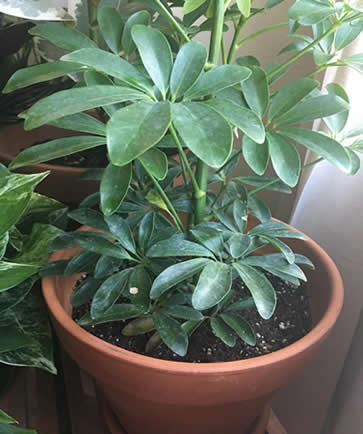
While they rarely bloom indoors, their thick, flexible stems make them ideal candidates for propagation through cuttings or air layering.
New plants rooted this way grow true to the parent, and with the right setup, they can thrive just as well.
Best Time to Propagate: When Growth Is Active
Spring through early summer is ideal.
During this period, the plant is actively growing, and new cuttings are more likely to root quickly and successfully.
Stem Cuttings in Water: The Most Popular Method
Using clean, sharp scissors or pruning shears, cut a healthy stem that’s 4–6 inches long with several leaf nodes.
Remove the lower leaves to expose at least one node (this is where roots will form).
Place the cutting in a jar of water or plant it directly in soil, depending on your preferred method.
If using soil, dip the cut end in rooting hormone (optional) before planting in a light, well-draining mix.
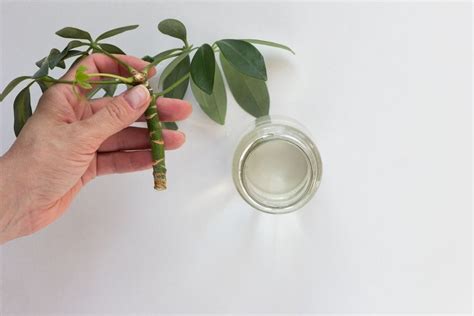
Bonus Tip: If rooting in water, add a drop or two of a balanced liquid houseplant fertilizer (such as 10-10-10 like this one) diluted to one-tenth strength.
This gives the cutting a gentle nutritional boost during root formation.
Place your cutting in a bright, warm spot with indirect light. Roots usually begin forming within 2–4 weeks.
Once they’re a few inches long, you can transplant the cutting into potting soil.
Propagation in Pots: A Soil-First Option That Skips the Jar
If you’d rather skip the water rooting phase, you can propagate Schefflera directly in a pot of soil.
Start with a cutting that’s 4–6 inches long with a few leaves and at least one visible node.
Remove the lower leaves to expose the node, and optionally dip the cut end in rooting hormone to encourage faster root development.
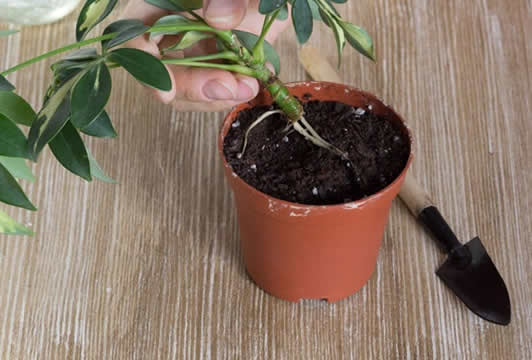
Plant the cutting about 1–2 inches deep in a small pot filled with a light, well-draining mix—something similar to standard indoor potting soil blended with perlite or sand for extra airflow.
Water lightly, just enough to settle the soil.
Cover the pot loosely with a clear plastic bag to trap humidity and place it in bright, indirect light.
Open the bag every few days to allow air in and check for moisture.
After 2–4 weeks, gently tug the stem—if there’s resistance, roots are forming.
Once the plant starts pushing out new growth, you can remove the plastic and continue normal care.
Air Layering: Great for Larger Plants
Air layering is a good choice if your Schefflera is too tall or leggy.
Select a healthy stem and make a small upward slice just below a node.
Insert a toothpick to keep the wound open, wrap moist sphagnum moss around it, and cover it with plastic wrap.
Keep the moss damp and wait 3–6 weeks.
Once roots develop inside the moss, cut below the new root ball and pot it as a new plant.
Propagation by Division: Rare but Possible
Mature Schefflera plants grown in clusters can sometimes be divided.
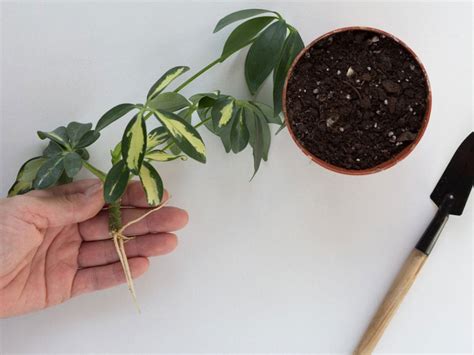
Remove the plant from its pot, gently separate the roots, and repot each section individually.
This works best for bushier, multi-stemmed varieties like Schefflera arboricola.
Outdoor Propagation: Warm Climates Only
In zones 10–12, you can propagate Schefflera outdoors using the same methods above.
Use a shaded, sheltered area to avoid direct sun, and make sure your soil is loose and drains well.
Warm, humid conditions will support root growth.
In cooler zones, propagate indoors and move your new plant outside once it’s established and night temperatures stay above 60°F.
Caring for New Plants: Keep It Gentle
Newly propagated Scheffleras need bright, indirect light and steady warmth.
Keep the soil lightly moist but not soggy, and wait to fertilize until you see new growth.
Once your plant is established, you can feed every 4–6 weeks with a balanced fertilizer diluted to half strength.
Prune lightly to shape the new plant and encourage branching.
For more detailed instructions be sure to read our article Umbrella Plant Care: How to Grow This Lush, Tree-Like Houseplant Indoors and Out.
Final Thoughts
Propagating a Schefflera is a great way to multiply a plant that already brings structure and style to your space.
Whether you root a cutting in water, try soil propagation, or experiment with air layering, the process is simple, rewarding, and surprisingly fast.
With warmth, light, and a little care, you’ll have a brand-new umbrella of your own before you know it.
Thanks for reading! I'm Michael — houseplant fanatic and your Pinterest plant guide.
Follow me on Pinterest for fresh updates 🌿



